| |



 |
|
By the time the first space shuttle had been christened
Enterprise in September 1976, Paramount officially green-lighted a Star
Trek movie with a budget of $10 million. Jerry Eisenberg was hired to
produce and Phil Kaufman to direct, with Ken Adam as production designer and
Ralph McQuarrie as production illustrator. The writers for this new film
venture were Chris Bryant and Allan Scott. Their script was titled
Planets of the Titans, and ultimately it, too, was rejected by Paramount.
About this time, the first Star Wars film was released and became an instant
blockbuster. Paramount executives, believing that the motion-picture
audience could support only one major science-fiction franchise, decided
that the tremendous impact of Star War doomed any chance of Star Trek's
succeeding at the box office.
But they also believed there was still value in the
franchise, so on June 10, 1977, Star Trek: Phase II was announced - a
brand-new syndicated Star Trek television series to be produced by
Roddenberry and Harold Livingston. Paramount had planned to make Phase II
the cornerstone of a new, fourth television network, but as the proposed new
network was not coming together as securely as Paramount had hoped, and
plans for it were canceled, Phase II was left a series without a home. At
the same time, 1977's other science-fiction blockbuster, Close Encounters
of the Third Kind, opened to box-office numbers rivaling those of Star
Wars. All at once, Paramount executives saw the error of their ways. Star
Wars had not been a one-time wonder. Determined to tap into the
science-fiction motion picture market with a Star Trek feature, Paramount
quickly made the decision to geen-light Phase II's pilot episode, "In Thy
Image", as a theatrical release, eventually bumping its television budget up
to $15 million, of which almost two-thirds would go to special effects.
 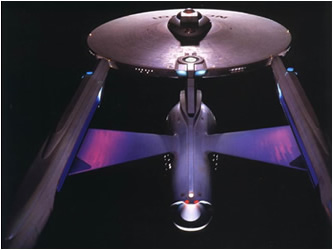
To recreate the magic of the original series, Gene
Roddenberry had gathered together those who had made that magic in the first
place. And they did it again. When Star Trek: The Motion Picture premiered
on December 7, 1979, Roddenberry's creation finally transcended the medium
of its creation, ceasing to be a mere television series, at last becoming a
true phenomenon.
The level of detail that can appear on a movie model is far
greater than that which can appear on a model for television. Thus, the
Enterprise built for the unproduced second television series was set aside
and a new model was constructed. The movie Enterprise still followed the
basic updating intially developed by Matthew Jefferies and Joe Jennings, but
new and more detailed modifications were added by a veriety of designers
from Abel & Associates and Magicam.

The final appearance of the new Enterprise interiors
combines the design input of original designer Matthew Jefferies, as well as
Mike Minor, Joe Jennings, movie production designer Harold Michaelson and
director Robert Wise. Control details were developed by Lee Cole, and
control screen readouts by Cole, along with Minor, Rick Sternbach and Jon
Povill. Harold Michaelson was responsible for the design of the attitude
dome on the bridge ceiling, as well as the redesigning of the Enterprise
corridors, which had been built for the second series. Gene Roddenberry had
been unhappy with the new corridors, because he felt they made the
Enterprise look too much like an hotel. Ironically, Michaelson's redesigns
ended up being used in The Next Generation's Enterprise-D, which was
criticized as looking even more like an hotel.
One of Andrew Probert's key concerns was that the sets he
designed would somehow conform to the structure of the starship they were
supposed to exist within. Here we see Probert's development sketches for an
officers' lounge in the saucer section's upper dome, of which an artistic
impression by Probert can be seen above.

Thoughts on the new Enterprise cargo decks
had already been visualized by
veteran Mike Minor, before Andrew Probert had a chance to address it. The
thinking, then under production designer Harold Michaelson,
was that the cargo bay would be a space 30 feet high that had two walls with
twelve holes containing cargo pods. An impression by Mike
Minor shows additional cargo pods simply stacked or lined up on the deck,
leaving a huge open and unused space above. Furthermore, the walkways along
the sides were rather old-fashioned looking.
The cargo bay scene would be part
live-action and part matte painting. Matte paintings are begun by filming a
plate; a shot of live-action scene in which elements, too expensive to build,
are needed. The left image below shows the plate of the cargo bay set,
filmed from Kirk's point of view as he enters the Enterprise. What Andrew
Probert was required to do was to get a frame of plate film and have it
printed at a pre-determined size. A part of this frim, required for the
live-action elements, would be cut out and pasted to a piece of illustration
board. The remaining blank board, intended to be the matte, would then be
painted around that piece, blending the two together.
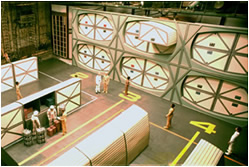
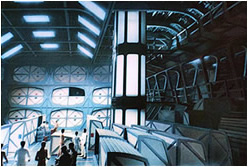
Following a discussion with special
effects director Donald Trumbull on how the cargo pods would get in and out
of the cargo deck, Andrew Probert draw an elevation sketch of the Enterprise
engineering section. He presented the sketch to Trumbull as a solution to
that problem, and Trumbull approved.
The next step was for Andrew Probert to
get some plate footage, and start his matte renderings. A matte rendering is
simply a painting that illustrates how the final scene might look like. Once
that image is approved by the director and the producers, it is sent to the
matte department, so that the matte painter can made the actual working
matte.
 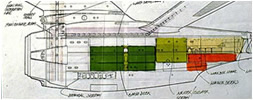
What Probert proposed was that the
landing bay and cargo bay be connected, allowing the easy passage of cargo
trains. The landing bay doors remain open, but atmospheric integrity is
maintained with a force field. The idea is that shuttles would normally take
off from and land in the landing bay. They then could be lowered to the
hanger bay level, or lowered
another level to shuttle maintenance. A multi-panelled
two-story door, between the elevators and cargo bay, has been opened to the
sides allowing the transfer of cargo.
 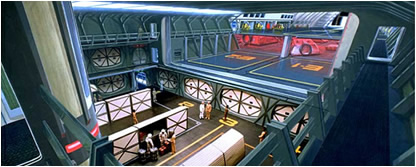
From a lower
angle, one can see the secondary rollaway decks
protruding somewhat from the sides of the bay. In their current retracted
position, they serve as a walkway at that level. The
idea here was that, once the main deck was filled with free-standing pods,
the second deck would slide together, doubling the available deck space. Not
an ideal solution, but one that worked with the plate footage that had
already been shot. The side doors, with red stripe
white lettering, would lead to a section of lifeboat stations located along
each side of the outer hull.
 
Throughout most of the filming of The Motion Picture, a
final ending had yet to be developed. Andrew Probert provided the
producers with his own script suggestions for a visually dramatic conclusion,
and storyboarded the key event. The possibility of the original Enterprise
undergoing a saucer seperation was first mentioned in the original series
episode "The Apple", but it was not until the pilot episode of The Next
Generation that the maneuver was finally depicted.

Eventually it was decided the climax of the movie would be
the walk to the heart of V'Ger, and the eventual merging of the Ilia-probe
and commander Decker. The walk
to V'Ger was to convey a sense of the extraordinary and fantastic by
using the new visual effects to complement the original film rather than
overwhelm it.
 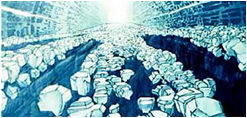
All material may be reproduced
under the Terms of Usage outlined in the legal
disclaimer. Simply stated, this means appropriate credit must be given in the form of a hyperlink.
For any content used by courtesy of a third party,
this third party is to be credited. |
|
|
 |
![]()